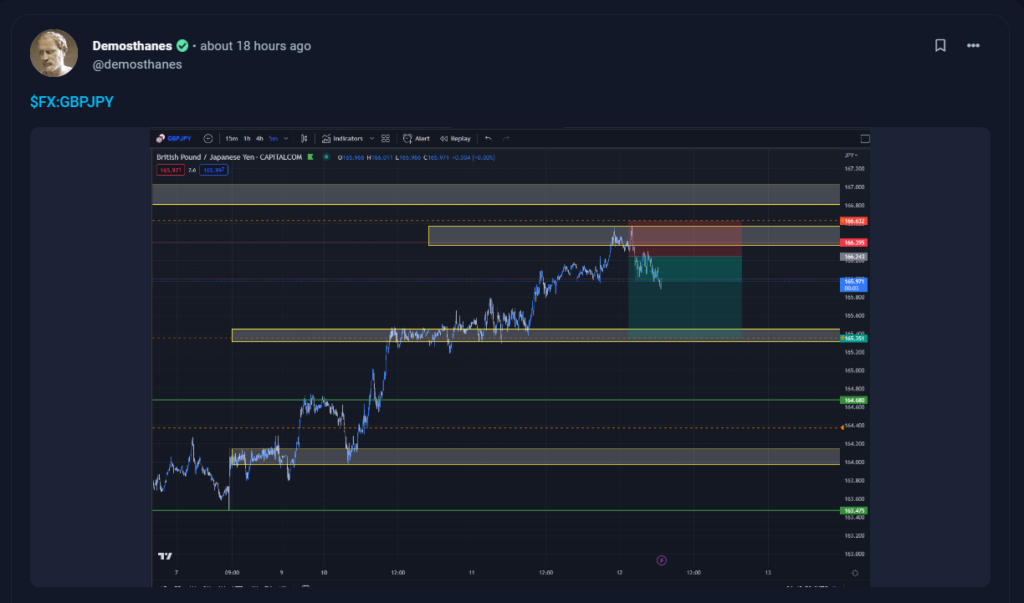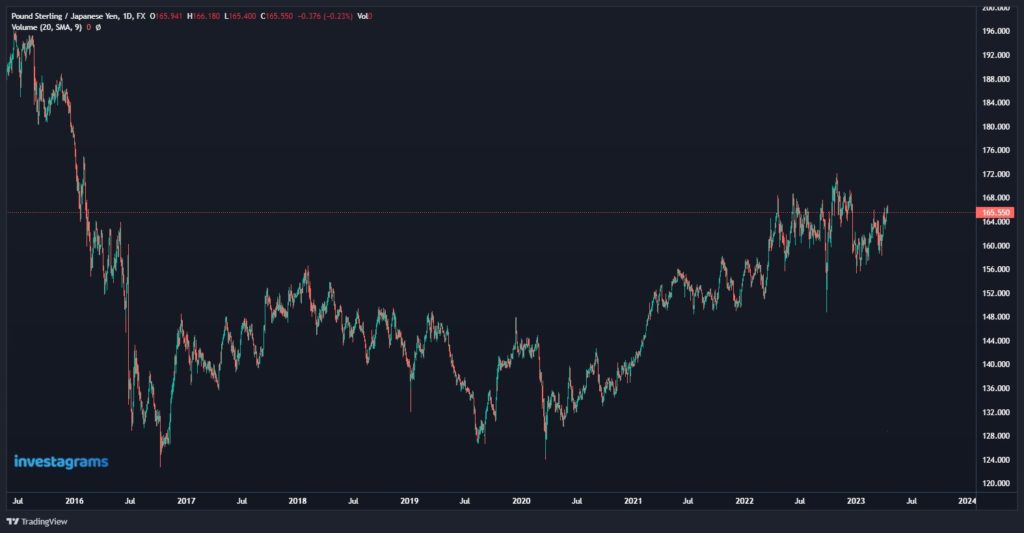@demosthanes takes the spotlight for this week’s featured trader! Read how he used simple support and resistance (or S/R) to set up a successful scalp trade in the $GBP/JPY.
As Dr. Alexander Elder once said, “Simplicity is the key to successful trading.”
In a scalp trade, a trader engages in a short-term trading strategy by purchasing and selling securities within a brief time span, typically ranging from a few minutes to a few hours.
Let’s take a look at how he used S/R for a clean trade set-up
ANALYSIS FROM @demosthanes

As shown in @demosthanes’ post, he entered once the price hit the 166.243 level. He has a stop loss set-up at the 166.632 level and aims to take profit at the 165.351 level. What can be observed in these levels is that they are near the local support and resistance levels. Stop losses are placed above the resistance level, and take profits are near the support level.
Since @demosthanes is short-selling, he is essentially betting that the asset’s price will decrease. Placing a stop loss above the resistance level helps to limit potential losses if the price does break through and continues to rise. On the other hand, placing a take profit near the support level allows him to profit from a downward move in the market while also being aware of potential support levels where the price may bounce back up.
TECHNICALS OF THE TRADE
For his simple yet effective short scalp set-up, @demosthanes maximized his use of support and resistance.
Short-selling in forex (foreign exchange) is the act of selling a currency pair with the intention of buying it back at a lower price in order to profit from the difference.
Traders commonly use support and resistance levels in all types of trading, including short-selling in forex.
Support levels are price points at which there is a higher demand for a currency pair, causing the price to bounce back up after reaching that level. Resistance levels are price points at which there is a higher supply of a currency pair, causing the price to bounce back down after reaching that level.
When short-selling in forex, traders can use support and resistance levels to identify potential entry and exit points for their trades. For example, a trader may look to enter a short position when the price of a currency pair reaches a resistance level, as they expect the price to bounce back down from that level. And as @demosthanes did in his execution, he put the stop loss above the resistance level and exited his trade at the support level.
FUNDAMENTALS OF THE TRADE
Recent Japanese economic reports state that the country is to expect price hikes and social system changes from April.
For the second consecutive year, households are being impacted by the effects of soaring materials prices, leading to widespread increases in the prices of food and services during the spring season, resulting in a strain on household finances.
According to a survey of 195 major food companies that Teikoku Databank Ltd. released late last month, prices are set to go up for 4,892 food products in April, in the third largest wave of price hikes on a monthly basis since January last year.
WHAT SHOULD BE YOUR NEXT MOVE

If you also plan to execute short-selling scalp trades like @demosthanes, you must take note that short-selling carries significant risks and requires careful consideration. The trader must have a solid understanding of technical analysis and risk management and a deep knowledge of the market and the factors that can affect the currency pair’s value. In addition, short-selling is often associated with high leverage, which can magnify both profits and losses. Therefore, it is vital to use stop-loss orders to limit potential losses and to monitor the trade to avoid significant losses closely.
With that being said, the currency pair is currently showing upward momentum in the bigger timeframe. You can use this bigger trend to guide how you would like to execute your scalping set-up. Make sure to use technical analysis to identify key support and resistance levels, as well as trend lines and other indicators. This will help you determine when to enter and exit trades. Keep a close eye on the market and be on the lookout for chances to quickly enter and exit trades, which may necessitate utilizing shorter time frames like 1-minute or 5-minute charts.
Once again, KUDOS to @demosthanes for being this week’s featured trader! Enjoy your 14-day InvestaPrime Access and continue to be an inspiration to the trading community.
Aside from your real-time PSE data access, let’s make your stock market journey easier with InvestaPrime!
For as low as P324, you can easily scan over a hundred stocks, set price alerts and have an automatic list of leading stocks to access in just a few taps:
Subscribe to Prime today!

